
Our DIY Water System
Nearly two years ago, we transitioned from simple 5-liter jerry cans with spouts to a "real" water system. As often happens, we couldn't find a pre-made system that suited us and fit into our concept. In our T4, we have very little space, everything must be maximized to the centimeter. In this article, we now present our water system and provide ideas if you are planning something similar.
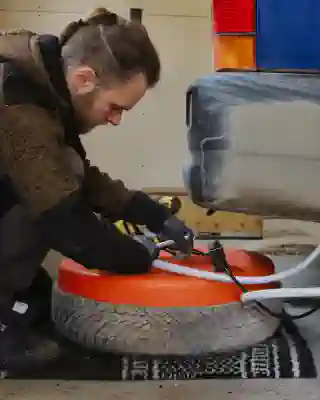
Advertisement, unpaid! This text is an editorial post that could unintentionally have a promotional effect on the reader without being commissioned by any company!
How It Started
We embarked on our journey without any camper conversion. It was a good idea because it allowed us to figure out what really matters. The same went for water - instead of tanks, pumps, and connections, we simply packed some 5-liter jerry cans and a spout that we would interchange.
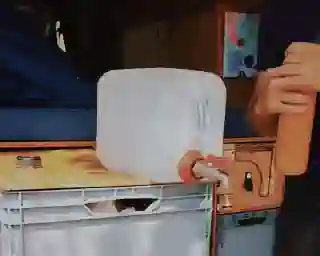
It was simple and cheap. No risk of leaks, we could refill at any source without worrying about connections, etc. Even if we couldn’t drive directly to the source, it wasn’t a problem since we could carry the cans.
The jerry can variant had only one significant disadvantage: it took up space. Precisely, the easily accessible, extremely valuable space in the van. When we adopted Nelly two years ago, we had to optimize that again. Two people and two dogs in the short T4, something had to give. For us, it was, among other things, the 6 5-liter water cans.
The Idea
For us, the only option to transport water from the interior to the exterior was an underbody tank. Since we are mostly traveling in warm climates, we didn’t want to transport our drinking water in the blazing sun on the roof. Also, you don’t want to unnecessarily raise the car’s center of gravity.
The underbody doesn’t offer much free space, especially in the short T4. Additionally, such a tank needs to be securely fastened if you don’t want it to be lifted off the road by the next bump.
The brilliant idea came when I remembered my father’s rapeseed oil conversion. They had various tanks! And lo and behold, one fit perfectly: a round, 15" large wheel well tank, tailor-made for the spare wheel holder!
So far, so good, but what about the spare wheel? It needed to be replaced anyway, as it had been happily rusting away under the chassis for 23 years… We found a great solution for that too, but that will be in another article.

Now we just needed a practical way to access the water in the tank. So, a pump was needed. Plus, Jo had long dreamed of a fancy faucet in the van…
In fact, with our first solution, we opted against a submersible pump and for an interior pump. We simply worried that if we ever traveled in colder regions, the pump might freeze and break. Today we are wiser: suction pumps are loud, consume incredible amounts of power, and don’t last long. A small submersible pump is more practical. When it gets cold (like in Canadian winter), we just have to pump the tank empty. And if something does happen, we can easily replace such an (inexpensive) pump.
The Plan
When faced with such a tank and not being a plumber, it can seem daunting at first. For just one faucet on such a tank, you need:
- An inlet line leading to the faucet
- A return line to be able to refill the tank
- An overflow to prevent the tank from bursting under pressure during filling
- A vent to allow air back into the tank when emptying
- A pump including power to get water out of the inlet
- Tank gauge/sensor to measure water level
- Additionally, we installed UV-C LEDs to sterilize the water in the tank.
To keep track of everything, it always helps to start with a rough plan:
The blue lines represent the water lines. We only need to lead the inlet and return lines into the vehicle; the overflow simply remains under the vehicle. The red (+) and black (-) lines represent the power lines. To avoid running three pairs of wires through the underbody, we combine the ground of the LEDs and the pump, as well as the positive of the LEDs and the tank sensor. Perhaps the tank sensor could have shared the same ground, but our tank gauge behaved a bit strangely once the pump was on.
Preparation
Once the plan was clear, the parts had to be procured. The tank already dictated a lot to us: the inlet had a 1/4 inch thread, the return 3/8 inch. For the LEDs, we simply drilled matching holes in the tank cap and glued them in with silicone. For the wiring under the body, we got a small waterproof junction box and a 4-core cable that we then led into the interior. For the water lines, we used food-grade braided hose with an inner diameter of 1/2 inch. (The size was coincidental; we used what was available at the hardware store…)
Since we had already removed the V80 blower from our T4, we already had free pass-throughs at the rear right. Above that was only the floor plate, which we had fitted. So we simply embedded waterproof cable glands in the floor plate over the holes and sealed them with tar paint.
Once inside, we simply crafted a Gardena fitting onto the end of the return hose for filling. The inlet goes to a 3/8 inch thread, through a shut-off valve and Y-piece to both connections (hot and cold) of the faucet. We use a salad bowl as a sink. We deliberately decided against a gray water tank for now. When the bowl is full, we have to dispose of it. This can be annoying, but it means we don’t have another (smelly) tank in the car.
For the water connections, we need:
- 1x Underbody tank with sensor and gauge
- 15m hose
- 2x Cable glands, large enough for the outer diameter of the hose
- 1x Hose fitting, 1/4 inch thread (tank inlet)
- 2```markdown x Hose fitting, 3/8 inch thread (tank return, faucet connection)
- 1x Hose fitting, 1/2 inch thread (return connection, Gardena attachment)
- 1x Gardena attachment, 1/2 inch thread
- 1x Shut-off valve, 3/8 inch thread
- 1x Y-piece, 3/8 inch thread
- 1x Faucet (Commercially available)
And for the electrical:
- 1x 12V submersible pump
- 2x 12V UV-C LEDs
- 5m 4-core cable ( min 1mm² cross-section for a 2A pump )
- 1x Waterproof junction box
- 2x Switch
- 1x Handful of Wago and/or terminal blocks :)
Installation
Let’s start INSIDE the tank: Here, only the submersible pump needs to be installed. Since this is very light, we don’t need to fix it much. The braided hose is rigid enough for us to simply “hang” the pump. The piece of hose between the tank cap and the pump just needs to be the right length so that the pump floats just above the tank bottom.
-
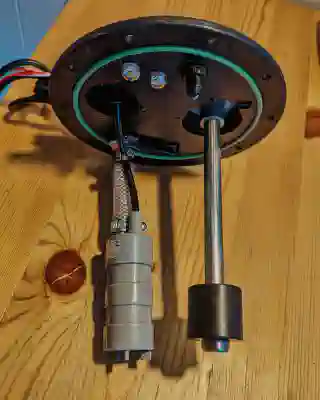
The tank cap from below. You can see the submersible pump, the tank sensor, and the UV-C LEDs. -
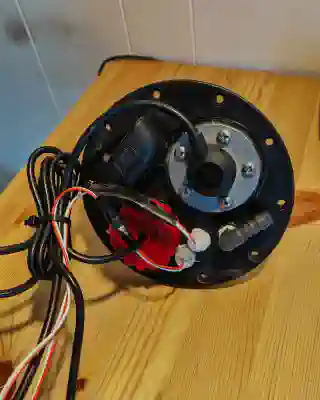
The tank cap from above. You can see the overflow connection and the wiring.
We removed the white threaded parts from the LEDs as the cap was too thick for the lock nut. We simply drilled a hole as fitting as possible for the waterproof casing of the LEDs and then glued them in with silicone.
We then routed the electrical connections for the LEDs and pump into the junction box and connected them to the 4-core cable according to the plan. We simply placed the box on the tank and fastened it with a cable tie to the connected hoses.
-
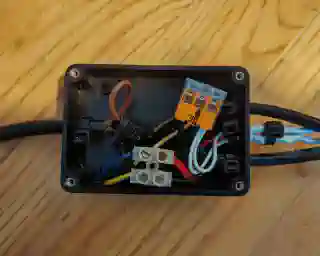
Inside the junction box. On the left, cables from the submersible pump, tank sensor, and LEDs go in; on the right, a 4-core cable comes out. -
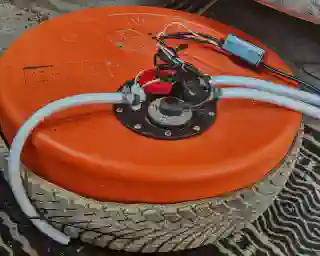
The junction box on the tank. You can see the overflow, which is directly led down from the tank and fixed.
To protect the tank itself, we got an old 15-inch tire from a tire dealer (they’re happy to give them away as they have to be disposed of expensively anyway). We then cut the tire open and placed the tank inside. For the overflow, we ran a short piece of hose down the side of the tank and attached it to the tire.
-
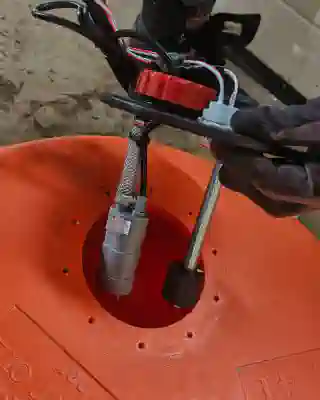
The tank cap just before installation. The pump and tank sensor are led into the tank. -
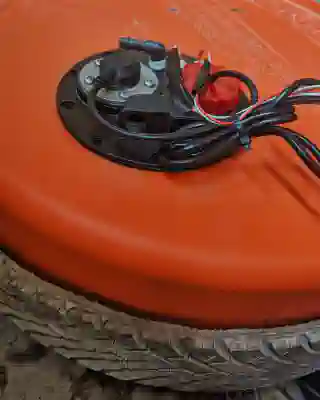
The tank cap before screwing into the tank. -
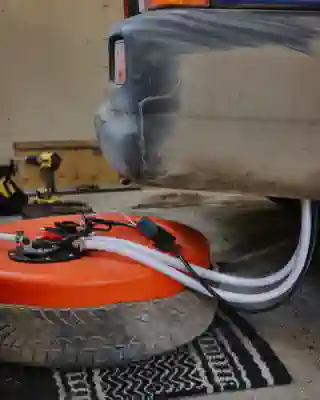
The tank with fully assembled connections, just before mounting on the underbody.
We then led the 4-core cable as well as the inlet and return through cable glands behind the right wheel arch into the interior. The return is simple; we attached it to the rear shelf with a broom holder. This allows easy access for filling, and we can even let the connection hang out a bit to the rear. The inlet leads over the wheel arch under the side shelf to the front, where it is connected to the faucet via a Y-piece.
-
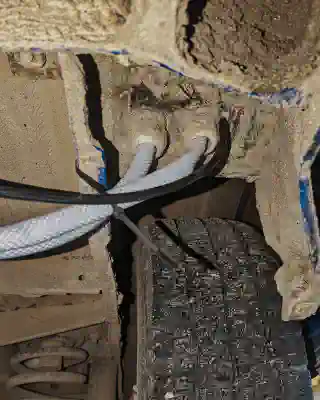
Inlet and return as well as cables for the electronics are led inside behind the right wheel arch. -
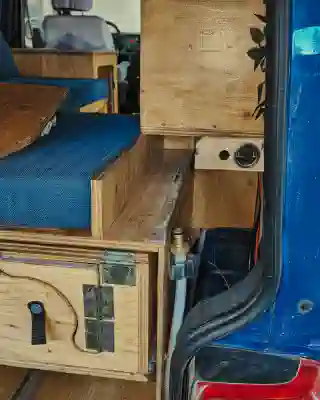
The return, attached with a broom holder to the side of the rear shelf.
The electrical part is a bit more complex. The switch for the LEDs, tank sensor, and gauge, as well as the tank gauge itself, are embedded in a small plate that we mounted above the wheel arch. This way, it’s out of the way but easily accessible. The lighting of the tank gauge is also connected to the switch, so you can easily see if the UV-C LEDs in the tank are on. We routed the switch for the submersible pump forward, right near the faucet.
-
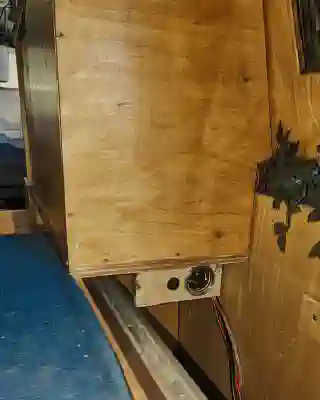
Tank gauge with switch on the underside of the wall cabinet. The switch activates the tank gauge and UV-C LEDs. -
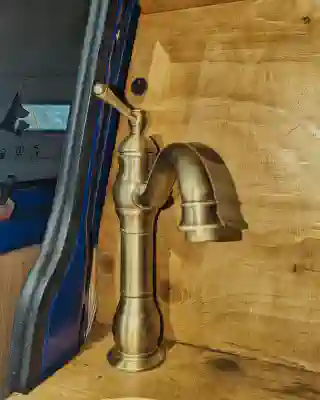
The faucet at the side door. Above it is the switch for the pump.
Conclusion
Such a water tank is a pretty complicated endeavor compared to simple water jugs. However, the tank underbody frees up a lot of space inside - and that space is precious to us. If space is not an issue, I would recommend simply planning a jug directly under the faucet. This saves a lot of installation work and returns to a simple system - both in installation and maintenance. I would now always recommend a submersible pump. It consumes significantly less energy and is much quieter. We are happy with our solution. Despite the effort, we used almost only parts that can be found at any hardware store around the world if needed. Because EVERYTHING you have WILL and CAN eventually break.
Have fun crafting!
Georg